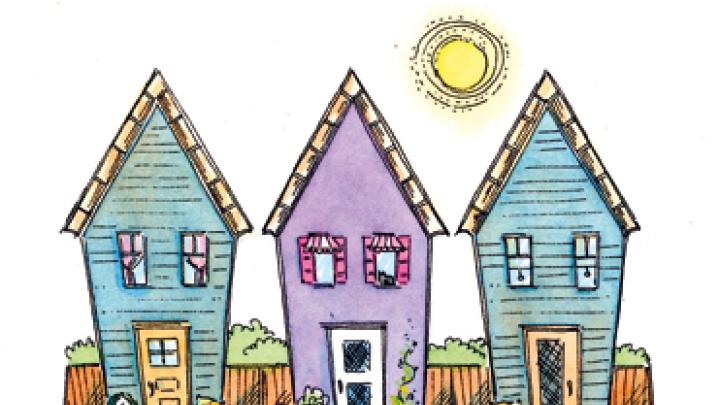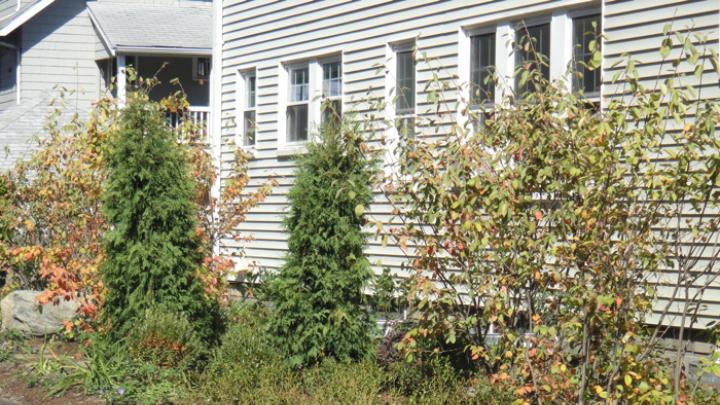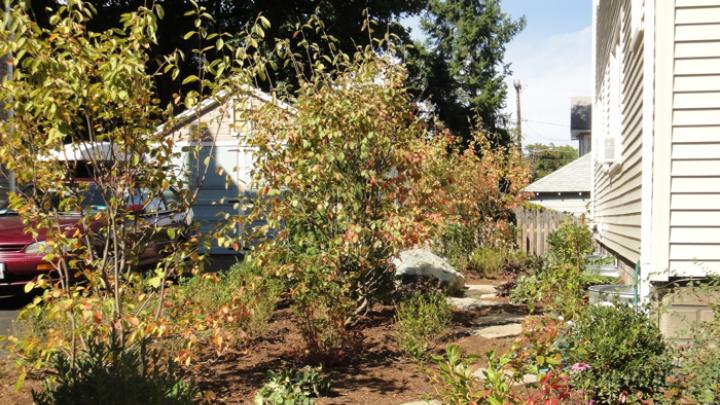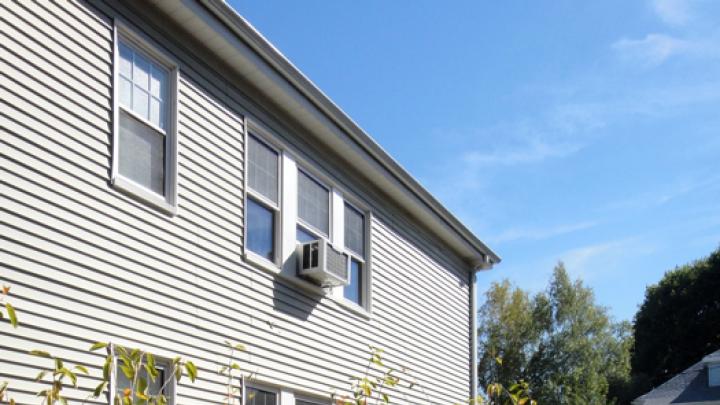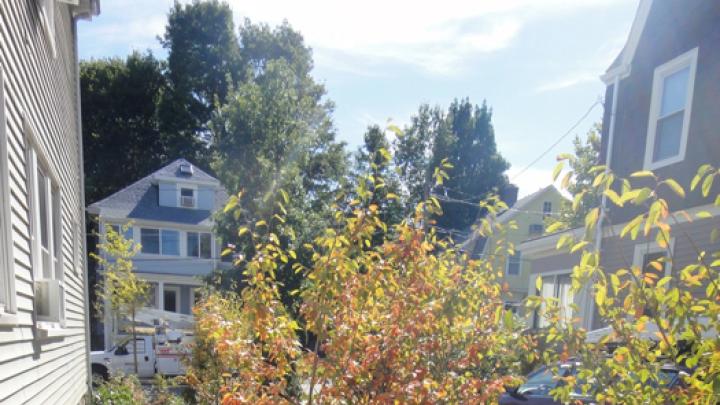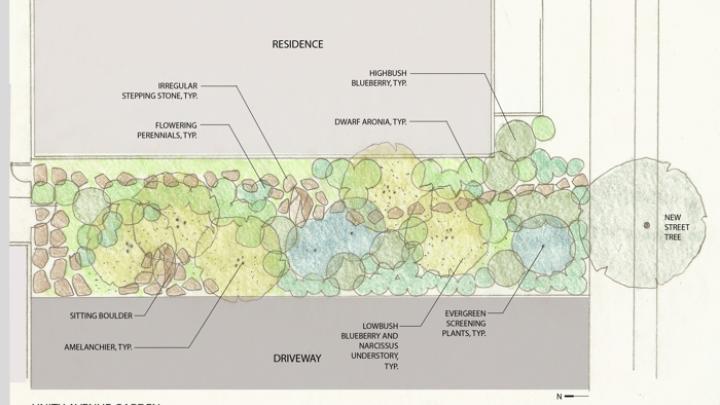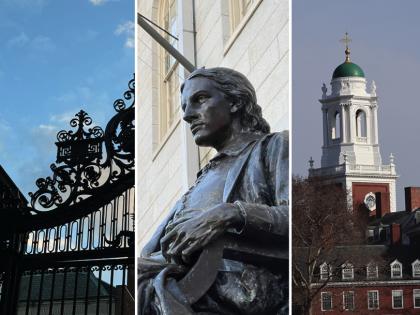Faced with large, unhealthy pine trees that grew too close to their home and had to come down, Hillary Wyon, A.L.M. ’08, and her neighbors joined forces to redesign their abutting yards--nixing the ubiquitous suburban lawn. “The people who lived here before us had the perfect lawn; they were very much the Roundup mentality,” says Wyon, who lives in Belmont, Massachusetts. “But we wanted to be chemical-free because it’s better for our pets and vegetable gardens. And watering lawns is such a waste.”
Wyon and her partner, Paul Williamson, had researched indigenous drought-tolerant grasses and ground covers, along with moss lawns. In the end they planted a combination of chamomile, thyme, and mint. “It’s really soft, low-growing greenery,” Wyon notes. “And when you walk on it, the leaves get crushed and produce fragrance.”
The two couples also added to the existing low- and high-bush blueberries and raspberries, and put in serviceberry and chokeberry trees, which birds love. On their part of the property, Wyon ripped up most of the rest of the turf in front and on the side and put in two raised-bed vegetable gardens. She plans to do the same in the backyard, using marigolds and other natural deterrents to animal cohabitants like rabbits, skunks, and squirrels. “I don’t like dandelions as much as anyone,” Wyon explains, “but getting rid of them is not worth pouring chemicals on the land that get into the air and the water and the environment.”
Botanist Peter Del Tredici, senior research scientist at the Arnold Arboretum, notes that Americans’ “ideal lawn”--that shimmering expanse of velvety emerald softness first manifest around English manor homes in the beginning of the 1700s--is, in fact, an artificially enhanced monoculture. It is a purely cosmetic landscape that “goes against the more heterogeneous natural landscape and requires tons of fertilizer, herbicides, pesticides, gasoline for mowing, and water, to be maintained,” says Del Tredici. “Which is horrifying.”
Think of the scale. Of the 116 million American households, only about 25 percent do not have yards or grass to take care of, says Bruce Butterfield, senior researcher for the National Gardening Association in Burlington, Vermont. If the typical suburban lawn is 5,000 square feet, he says, that translates into a huge portion of the American landscape, even if most are individual “postage-stamp-sized” yards. According to an analysis of NASA satellite data, turf covers about 49,421 square miles of American land--representing three times more acreage in the nation than irrigated corn.
Think of the money. In 2009, individuals spent about $20 billion on lawn care in the United States--which is only a fraction of what the industrial, athletic, and other commercial entities spend on perfecting their turf, he adds. Why? “Lawns are often about self-image; the identity with a manicured lawn suggests higher status,” Butterfield asserts. “People think of golf courses and country clubs and mansions. The big fertilizer companies really play into this with their commercials. The message is: If you have dandelions in your lawn, you’re a bad person; you’re lazy and you’re an eyesore in the neighborhood and you should be ashamed of yourself.”
Lawns have been around in America in some form since the turn of the eighteenth century, although they were minimal and there to feed (and were maintained by) grazing animals. Thomas Jefferson and George Washington, among other well-off landowners, were influenced by the majestic grounds of contemporary English gentry and aspects of those landscapes, including lawns, turned up on their own estates.
Grass, which grew much more easily in England, was critical to animal husbandry. “During the eighteenth century, European pasture plants including timothy and fowl-meadow grass and the legumes red clover and alfalfa were common as pasture grasses throughout the colonies,” according to Redesigning the American Lawn: A Search for Environmental Harmony, by F. Herbert Bormann, Diana Balmori, and Gordon T. Geballe. Native New England grasses were not as easily grown or digestible by livestock, so seed combinations were often imported from England. With the coming of the Industrial Revolution, newly middle-class families who could afford to moved out of the cities, and detached housing soon prevailed, preferably surrounded by a green yard, which the owners believed created “reservoirs of clean air and healthy home environments.”
The lawn, carrying the English connotations of nature with it, became a symbol of prestige in nineteenth-century suburbs. Similarly, centers of towns in New England, the old “commons,” which had been the setting for such useful activities as rope-making, hay-growing, military drills, and town fairs of the eighteenth century, were transformed from bare stamped earth, cultivated fields, or cemetery grounds into lawned and treed parks, now called “greens.”
In her 2008 New Yorker article, “Turf War,” Elizabeth Kolbert credits Andrew Jackson Downing, a nursery owner, with publishing the first landscape gardening book for Americans in 1841, encouraging people to beautify their front yards through careful plantings and sculpting of the landscape--ideas that influenced Frederick Law Olmsted’s grand lawns of Central Park, as well as planned suburban communities like Riverside, Illinois. The prevalence of the more expansive, individually mowed lawn appeared in the later nineteenth century (the first push mower became available in 1870), along with the burgeoning American suburb.
The Garden Club of America, founded in 1913, also promoted tidy personal lawns and yards, running contests and publicity drives to promote “a plot with a single type of grass with no intruding weeds, kept mown at a height of an inch and a half, uniformly green, and neatly edged,” reports Virginia Scott Jenkins in The Lawn: A History of an American Obsession. Also significant, Peter Del Tredici points out, was the collaborative research venture between the U.S. Department of Agriculture and the U.S. Golf Association that resulted, by 1930, in feasible combinations of lawn grasses that would grow well in a variety of American climates. The marketing of herbicides, pesticides, and fertilizers came later, sometimes in conjunction with chemical research associated with World War II.
Anti-lawn sentiment has been building during the last two decades, however, given the climate crisis. Motivated by books like Redesigning the American Lawn and Sally and Andy Wasowski’s The Landscaping Revolution: Garden with Mother Nature, Not Against Her--and by research on the effects of petrochemicals on drinking water and air quality--many people are calling for a radical rethinking of our entrenched aesthetic views. “The big thing,” maintains Del Tredici, author of Wild Urban Plants of the Northeast, “is to get people to stop thinking that the turf has to be made up of one species of grass.”
He would argue that there is no true functional, natural, vegetative substitute for the “soft carpet” of a well-maintained lawn: “Ground covers and meadows do not fit in that category.” Instead, he favors the “freedom lawn” concept discussed in Redesigning the American Lawn. That calls for a green expanse composed of a community of plants that “sort themselves out according to the topographical gradient that is most peoples’ lawns,” he explains. There are varying soil conditions, and spots that are sunnier or shadier, or wetter or drier, areas closer to trees and other root systems, et cetera. The freedom lawn is not all grass, or even one kind of grass: it has dandelions, clover, and buttercups, too. “You can plant crocus and violets and ajuga. You can still walk on it and let them spread on their own with minimal mowing and no petrochemicals,” Del Tredici points out. “Before herbicides were invented and promoted, people accepted dandelions and clover and other flowers as the inevitable reality they are.” The problem is not the lawn, per se, he emphasizes, but all the petrochemicals and water used to keep it green and weed-free.
Bruce Butterfield also sees this centrist approach to lawns as constructive. “To me, there is a continuum from a highly manicured ‘golf course’ lawn to one that is not cared for at all,” he says. He recommends Cornell University’s website, www.gardening.cornell.edu/lawn/index.html, for its reasonable guidance on lawn care. Butterfield himself lives on 150 acres in northern Vermont, having moved from Burlington “because it was beginning to look like New Jersey.” He keeps about three acres of lawn mowed and uses no chemicals. “The primary question is, ‘How do we approach this in a balanced way so our landscape looks good and is good for the plants and earthworms and animals and people?’” he adds. “Because for many people in America, it’s not a choice whether they’re going to have lawn. It’s ‘How are we going to manage it?’”
Harvard University faces this very question when confronting its 80 acres of turf in Cambridge. Landscape manager Wayne P. Carbone has overseen a significant change in lawn care practices since 2007, when a test patch in the Yard showed that organic techniques produced better results in terms of soil improvements and enhanced microbial activity. That, in turn, generated turf that was healthier and had a deeper root system because it was less dependent on fertilizer and irrigation. “It really opened my eyes,” says Carbone, who had been schooled in and practiced conventional, synthetic, chemical landscape maintenance for more than two decades. “At home now I use compost ‘teas’ and have eliminated synthetic fertilizers.”
Most people do not understand what cool-weather grass needs to grow healthily, says the Arnold Arboretum’s manager of horticulture, Steve Schneider, A.L.M. ’10. By using too much fertilizer and water, and mowing the turf too often, Schneider says, they hurt root development--and shallower, weaker roots are more vulnerable to pests and invasive species and cannot winter over properly. “When people think their lawns don’t look good, it’s often not because of grubs or insects or weeds, it’s because of poor watering and mowing practices,” he reports. “But people don’t realize this, and tend to water more and fertilize more. And they don’t really think about what that means: chemicals leaching off into the water supply and bacterial ‘blooms’ that kill fish. Ultimately, this leads to polluting our resources. It’s a vicious cycle all because people want lawns--which are not necessary.”
Carbone has found that alternative organic practices--focused on soils management, moisture retention, aeration, composting, and optimizing nitrogen and nutrient cycling through microbes and fungi--have not only enabled his crews to give up synthetic chemicals, but have also significantly reduced mowing and irrigation rates. “The grass is not growing as vigorously as it did when you’re applying 36 percent nitrogen fertilizer on top of it. And our water use is down by about three million gallons in Harvard Yard,” he reports. “We now take all the yard waste to the Arnold Arboretum and compost it with different recipes, depending on what we want to do with the soil.” (The crews use only nominal amounts of coffee and vegetable waste from the dining halls for composting; much of that uneaten food is trucked to a pig farm. To read more about Harvard’s program, visit www.uos.harvard.edu/fmo/landscape/organiclandscaping.)
The Arboretum has minimal manicured grassy areas, which are mown but not fertilized. But arboretums and botanical gardens have more leeway for experimentation and “messy” landscapes than do corporate headquarters, golf courses, and universities, where expectations about containing nature run high. “It’s a lot easier to run a mower over a surface and be done with it than manage a water garden or perennials or even a wildflower meadow,” Schneider says, especially “when you’re dealing with stakeholders who are walking by the site and don’t know it’s supposed to be an educational experiment, or an environmentally friendly lawn, and start screaming that ‘Someone hasn’t mown the lawn!’ Changing ideas about the perfect lawn is really about re-educating people to think in a completely different way.”
Most of the grounds surrounding the Arboretum’s new Weld Hill research facility consist of a new “metropolitan meadow mix” that includes various grasses and hardy wildflowers. Schneider says that it can be planted on any scale, “but would Harvard Yard buy into it? Probably not, because in that setting it could look ‘unkempt’ because, psychologically, people still expect to see green grass.”
A more sustainable alternative to the usual lawn has been installed outside Harvard’s LEED-certified 46 Blackstone Street building in Cambridge. The space is hilly and contains various fescues--hay-like grasses--that are low-mow (three times a year) and drought-resistant. But the new look has taken some getting used to; not everyone adores the less controlled look, or the ryegrasses that were also planted initially and grew two to three feet high. “It could look like a hayfield, and people joked that I should get some goats out there,” Carbone reports.
Meanwhile, with the lawn mostly gone from the front of her house, Hillary Wyon says her goals--“to not use so much water, use indigenous plants or those that grow easily here, and plant more fruits and vegetables”--are being met. “There are a lot of alternatives,” she adds, “for having a nice green space that is more natural than a lawn.”
